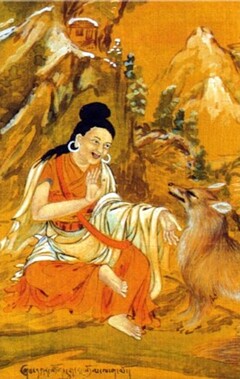Madhyamaka, Dzogchen, and Mahāmudrā
Pure Perception of Madhyamaka, Dzogchen, and Mahāmudrā[1]
by Shabkar Tsokdruk Rangdrol
I pay homage to the Lord of the Teachings, the Teacher-Buddha,
And to the holders of the teachings, the scholar-siddhas of India
and Tibet.
Please grant your blessings so that the essence of the teachings—
Madhyamaka, Dzogchen, and Mahāmudrā—may spread and increase.
Dzogchen, in which saṃsāra and nirvāṇa are perfected in the
mind,
Mahāmudrā, which is free from abandoning and adopting existence
and liberation,
And Madhyamaka, which is free from the eight extremes of conceptual
elaboration—[2]
These three views have long been famous in Tibet.
Rechung Dorje Drak, heart-son of Milarepa, said that
The view of Dzogchen is beyond partiality and bias,
The view of Mahāmudrā is beyond negation and proof,
And the view of great Madhyamaka is beyond identification.
The Dharma Lord Tsangpa Gyaré[3] said that
He bathed in the assurance of the view of Dzogchen,
Saw the essence of the view of Mahāmudrā,
And slept within the view of great Madhyamaka.
The great paṇḍita Lobzang Chögyen[4] said that
For a yogin with knowledge and experience
All views such as the three of Madhyamaka, Dzogchen and Mahāmudrā,
When analyzed, would be established as having a single intent.
Thus, I have trained in pure perception and practiced whatever I
could
Of the Madhyamaka, Dzogchen, and Mahāmudrā teachings.
May subsequent generations also train in pure perception
And, through whichever they practice, attain buddhahood!
| Translated by Rachel Pang, 2014. Edited for Lotsawa House and published with permission, 2023.
Bibliography
Tibetan Edition
zhabs dkar tshogs drug rang grol. zhabs dkar tshogs drug rang grol kyi bka' 'bum. New Delhi: Shechen Publications, 2003. Vol. 2: 236–237
Secondary Sources
Pang, Rachel H. “The Rimé Activities of Shabkar Tsokdruk Rangdrol (1781-1851)”, Revue d’Etudes Tibétaines, no. 29, Avril 2014, pp. 5-30.
Ricard, Matthieu. The Life of Shabkar: The Autobiography of a Tibetan Yogin. Albany: State University of New Tork Press, 1994.
Version: 1.1-20230512
-
The original is untitled; this title has been added by the translator. ↩
-
The eight extremes of conceptual elaboration (spros pa'i mtha' brgyad) are: arising (skye), cessation ('gag), permanence (rtag), non-existence or annihilation (chad), going ('gro) coming ('ong), singularity (gcig) and plurality or multiplicity (tha dad). ↩
-
Tsangpa Gyaré Yeshe Dorje (1161–1211) was the founder of Druk Monastery. See https://www.lotsawahouse.org/tibetan-masters/tsangpa-gyare-yeshe-dorje/ ↩
-
Paṇchen Lobzang Chökyi Gyaltsen (1570–1662) was the first or fourth Paṇchen Lama (depending on the method of counting). See https://www.lotsawahouse.org/tibetan-masters/lobzang-chokyi-gyaltsen/ ↩
